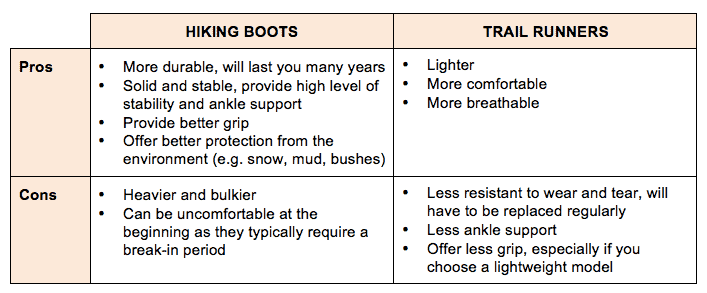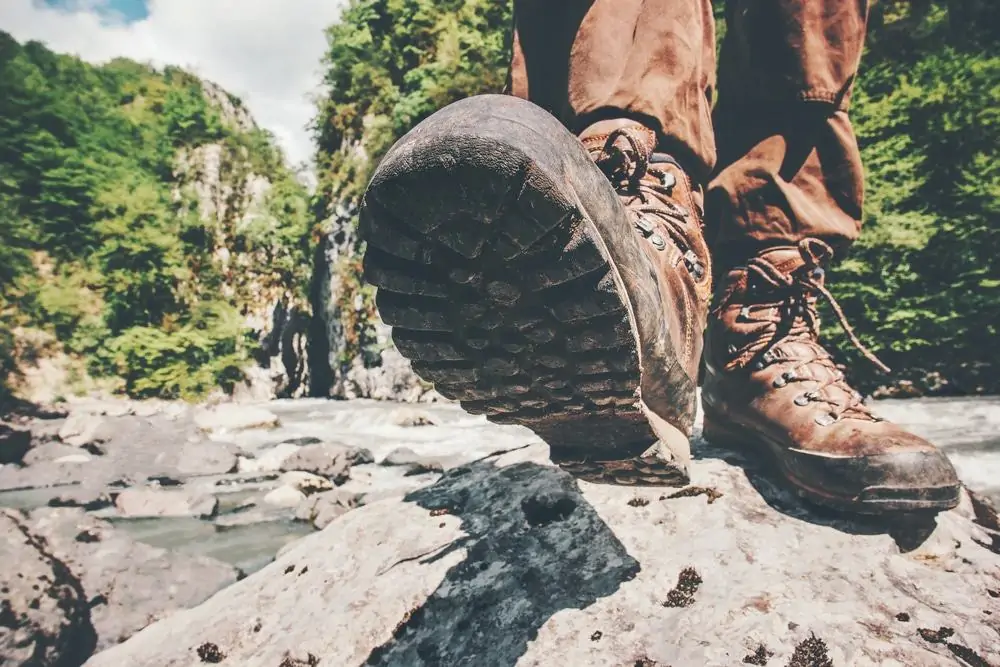
Having the right footwear is immensely important on Mount Kilimanjaro. With every step you take, and you will take thousands, your shoe has to perform well. There is no piece of gear that is more crucial than your footwear.
Your shoes serve a few purposes:
- They provide protection by creating a barrier between your feet and the trail.
- They provide grip on loose or slippery surfaces.
- They provide support and cushioning for your feet.
- They keep your feet warm and dry in cold and wet weather.
Let’s discuss the three types of shoes that are used in hiking and backpacking.
Hiking Shoes, Trail Runners
Hiking shoes, or trail runners, are typically lightweight, flexible shoes that offer moderate cushioning, traction and stability. They are an excellent choice for climbing Kilimanjaro. On the mountain, you will probably never carry more than 15-20 lbs., so this level of padding generally works well.
The difference between hiking shoes and regular gym shoes has to do with mostly with the tread. Gym shoes are made for court surfaces such as wood or pavement. Therefore, they lack deep tread that gives traction on natural substrates like gravel, mud and dirt. Furthermore, hiking shoes have extra cushioning to absorb the shock of carrying a pack.
The main advantage of hiking shoes over boots is their weight. Studies show that the lighter the shoe, the less energy it takes to hike in them. These energy savings really add up when doing a multi-day trip. Many people favor hiking shoes on Kilimanjaro for that reason. We strongly recommend waterproof shoes as they are better suited to deal with the wet, possibly snowy and cold weather conditions.
Hiking Boots
Hiking boots offer more support and durability than hiking shoes. They come in mid-cut and high-cut models. Reasons to choose boots over shoes include greater protection, warmth, stability, traction and cushioning.
If you tend to get sore feet and achy bones, going with hiking boots makes sense. If your feet get cold easily or you have a propensity to roll your ankles, use hiking boots. If you want better traction and more secure step, choose hiking boots.
The main drawback is that they are heavier, so you use more energy wearing them. Additionally, hiking boots are not as breathable as shoes. This can be good or bad. Your feet can become too hot during warm conditions, but on the flipside they will stay warmer in cold summit conditions.
A good portion of our clients use hiking boots on Kilimanjaro with great success. We recommend waterproof boots made of synthetic upper. Be sure to break them in. Don’t bring new boots to Tanzania.
Backpacking Boots
Backpacking boots are the sturdiest of the footwear options. They are stiff boots, with even more support and cushioning. Backpacking boots are made to be used when carrying heavy loads. So they have characteristics that provide greater stability and safety to the user. We do not recommend backpacking boots for Kilimanjaro unless you have a condition that requires such a heavy duty boot. Walking in backpacking boots is the least comfortable and most inefficient when compared to trail shoes and hiking boots.
Pros and Cons of Boots vs. Shoes

Fit is Key for Kilimanjaro Footwear
Choosing the right hiking footwear can be a long, drawn out process.
For some, finding a shoe that works is as easy as picking up a pair off the shelf. That’s because some people have feet with the right size and shape that manufacturers design their shoes around. These lucky individuals don’t need to test and retest their selections because in general they can wear any shoe. Most of us aren’t that lucky. We have feet that have variances that can make one pair of shoes unbearable while a similar pair might be perfect.
First and foremost, your shoes must be comfortable – for long periods of time. What feels fine at the shop or after a few hours may not be so good after a whole day of walking. You want to wear your shoes thoroughly before you come to Kilimanjaro. Make sure that your footwear doesn’t cause hot spots, blisters or other abrasions after extended use.
Most people wear shoes that are too small for their feet! A good rule of thumb is that there should be a thumb’s width of space between your longest toe and the end of the shoe. You need that extra space so your toes don’t touch your shoe on the downhill sections and to account for the normal swelling that occurs as you hike over several hours. Our feet normally expand by 5% during the day. Keep this in mind when sizing hiking shoes. If you have any doubts, go to a local gear shop and get your feet measured by a professional.

The Winning Combination
Our clients often ask us if they should bring shoes or boots. The easy answer is, use whatever you are accustomed to hiking in. We have guided thousands of clients and they have used both shoes and boots successfully. We do not see any issue or difference between opting for one type of footwear over another.
An even easier answer is to bring both! You can wear a pair of light hiking shoes for the bulk of your climb and at camp in the evenings. Then switch to the hiking boots for the summit day, as you may need more warmth during the cold night.





